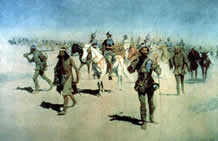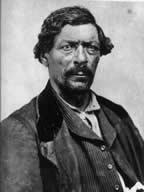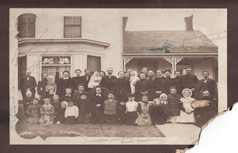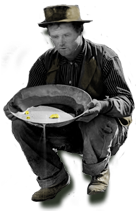 The area that eventually became Colorado, was first claimed by Spain in the 16th century, and by France in the 18th century. Spain traced its claim to the southwestern US to the 1540 Coronado expedition that explored much of New Mexico and Arizona. While he probably didn't reach present day Colorado, that didn't keep Spain from citing the trip as precedence for a claim to the Rio Grande and Colorado river basins.
[1]
The area that eventually became Colorado, was first claimed by Spain in the 16th century, and by France in the 18th century. Spain traced its claim to the southwestern US to the 1540 Coronado expedition that explored much of New Mexico and Arizona. While he probably didn't reach present day Colorado, that didn't keep Spain from citing the trip as precedence for a claim to the Rio Grande and Colorado river basins.
[1]
The first Spanish settlements on the middle Rio Grande were in 1598. Spanish explorers had to have reached Colorado prior to 1694 since the written record from the Don Diego de Vargas 1694 trip into southern Colorado refers to already named landmarks that he passed.
Colorado was acquired in part by the Louisiana Purchase (1803) and explored by U.S. Army officers Zebulon Pike (1806), Stephen Long (1819-20), and John Fremont (1842-43). Additional lands came from Mexico in 1848 as a result of the Mexican War, and from Texas in 1850.
Early Spanish explorers who came to Mexico heard the natives tell exciting tales of cities of gold and silver to the north. To find the precious metals many of these fortune hunters pressed northward, some of them coming into sections of the present New Mexico, Arizona, Utah, and Colorado. Some of these adventurers were the first white men to see the Grand Canyon of the Colorado, the Rio Grande Valley, and other sections of the Rocky Mountain Territory. Escalante, the Catholic priest who tried to find a shortcut from Santa Fe to the Pacific coast, came through there on his unsuccessful trip in the summer of 1776. [2]
 About fifty years later these sections swarmed with competing trappers and fur traders working for the various large fur companies of the eastern United States and Canada. Approximately 3,000 mountain men ranged the mountains between 1820 and 1840, the peak beaver-harvesting period. While there were many free trappers, most mountain men were employed by major fur companies. The life of a company man was almost militarized. The men had mess groups, hunted and trapped in brigades and always reported to the head of the trapping party.
[3]
About fifty years later these sections swarmed with competing trappers and fur traders working for the various large fur companies of the eastern United States and Canada. Approximately 3,000 mountain men ranged the mountains between 1820 and 1840, the peak beaver-harvesting period. While there were many free trappers, most mountain men were employed by major fur companies. The life of a company man was almost militarized. The men had mess groups, hunted and trapped in brigades and always reported to the head of the trapping party.
[3]
 The real settlers of Colorado came about 1858, thus making the state the last to be occupied by permanent settlers. Many of the first comers were attracted by the discovery of gold and other metals. Not too successful in their fortune hunt, they turned to the land and the ranges for their livelihood.
The real settlers of Colorado came about 1858, thus making the state the last to be occupied by permanent settlers. Many of the first comers were attracted by the discovery of gold and other metals. Not too successful in their fortune hunt, they turned to the land and the ranges for their livelihood.
The territory of Jefferson was voted by the residents in 1859 but was never recognized by congress. Thus some of the counties have organization dates and records prior to 28 February 1861 when the Territory of Colorado was recognized. [4]
The 1860 census showed a population of about 33,000 men, and 1,500 women. This was taken when Colorado was still a part of Kansas.
The first territorial assembly created the first seventeen counties in September 1861. They were Arapahoe, Boulder, Clear Creek, Costilla, Douglas, El Paso, Fremont, Gilpin, Guadalupe (later named Conejos), Huerfano, Jefferson, Lake, Larimer, Park, Pueblo, Summit and Weld.
Three of Colorado's earliest communities had the honor of serving as capital of Colorado Territory:
- Colorado City (1861–1862)
- Golden City (1862–1867)
- Denver City (1867–1876)
The United States Congress passed an enabling act on March 3, 1875, specifying the requirements for the Territory of Colorado to become a state. On August 1, 1876 (28 days after the Centennial of the United States), U.S. President Ulysses S. Grant signed a proclamation admitting the state of Colorado to the Union as the 38th state and earning it the moniker "Centennial State".The borders of the new state coincided with the borders established for the Colorado Territory. The obvious choice for the State Capital was Denver, since it was already the Territorial Capital. However, the mountain town of Central City (near where the first gold was discovered), almost beat Denver out. Afterall, at the time, Central City not only had more culture than Denver, it had all that gold!
Women won the right to vote in Colorado in 1893. Colorado was the first state in the union to grant this right to women through a popular election, and the second to grant women, suffrage. (Wyoming approved the right of women to vote in 1869 through a vote of the territorial legislature.)
A few birth records before January 1907 may be obtained at the office of the county registrars, after January 1907 at the State Bureau of Vital Statistics in Denver. A few death records before January 1900 may be obtained from the respective county registrars. After these dates, from the State Bureau of Vital Statistics in Denver.
Marriage records were not generally recorded until after 1881, but some counties have marriage records as early as 1860, and are kept by the county clerks, as are probate matters, wills, etc. All land titles, deeds, mortgages, leases, etc are kept by the individual county recorders.
Helpful Links on Colorado History:
Footnotes:
[1] http://thenagain.info/webchron/northamerica/coronado.html
[2]"http://www.factmonster.com/ce6/.html." The Columbia Electronic Encyclopedia.
© 1994, 2000-2006, on Fact Monster.
© 2000–2007 Pearson Education, publishing as Fact Monster.
27 Apr. 2011 <http://www.factmonster.com/ce6/people/A0817659.html>.
[4] The Statutes at Large, Treaties and Proclamations of the United States of America from December 5, 1859 to March 3, 1863. Ed. By George P. Sanger. Vol. 12, pp.172-177. Boston: Little, Brown and Company, 1863.
Historical Atlas of Colorado", Thomas Noel, Paul Mahoney and Richard Stevens, Univ of Oklahoma Press, 1994.
The Colorado Archives:
Colorado State Government History Page
Family Search:
Colorado History
